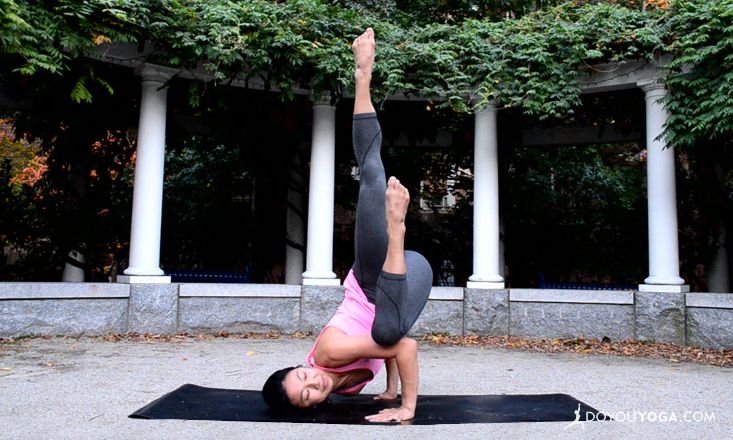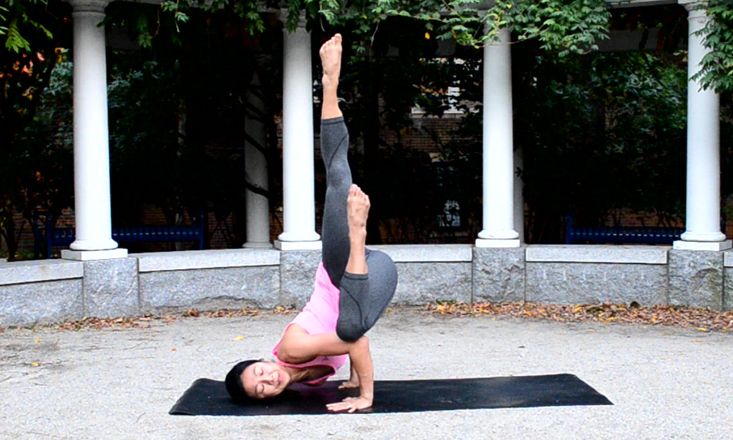While fall is a great time to cozy up inside with a good book and tea, you can spice up your yoga practice with a bit more than turmeric this year and try Fallen Angel Pose. It’s a modern spin that adds a bit more height to Eka Pada Koundinyasana I.
Fallen Angel is an arm balance with a twist (from the navel). A fun and funky addition to any practice, this pose is best done after warming up the body with 3-5 rounds of Surya Namaskar A (Sun Salutation A) and 3-5 rounds of Surya Namaskar B (Sun Salutation B).
Preparatory Poses
1. Open the Spine in Ardha Matsyendrasana
Fallen Angel requires a great deal of strength in the arms, legs, and core, it is a full-body workout. Regardless of strength, it is impossible to begin Fallen Angel if the back body is too tight for the upper arm to twist and make contact with the opposite thigh.
Ardha Matsyendrasana is the perfect pose to open the back body as well as the shoulders, hips, and neck.
2. Balance Play in Bakasana and Parsva Bakasana
Credit: Sarah Smith
Fallen Angel is primarily an arm balance and minimal to no weight is suggested to be placed on the head and neck. Therefore, strengthening the core and arms is essential to keep lightness in this pose.
Bakasana or Crow pose is a helpful preparatory pose because it strengthens the arms, wrists, upper back, and core which aid in the floating gracefully down rather than falling hard in Fallen Angel. Parsva Bakasana or Side Crow (pictured above) is the next step in preparation and balance play.
3. Train the Brain in Eka Pada Koundinyasana I
Visually, it is obviously that Fallen Angel closely resembles Eka Pada Koundinyasana I. Physically the two poses require similar muscle engagement and joint mobility. Therefore, practicing Eka Pada Koundinyasana I aids the body in preparation for Fallen Angel without putting as much risk on falling on the head and neck.
Step-By-Step Guide to Fallen Angel Pose
1. Build A Foundation with Toes on the Ground
Starting in a crouched position with the legs hugging together, walk both hands gently to one side. The arms should be a little wider than hip-distance apart. A good rule of thumb on arm placement is this: imagine where they are comfortable and supportive in Chaturanga Dandasana or Bakasana—that is where they are a good fit for you in Fallen Angel.
Now start to slowly tip the shoulders over the wrists and have the shoulders stop in line with the elbows. Keep the toes on the ground, or close to the ground for now—this is the time to play with opening the side body in a twist at the navel. The drishti (gaze) can be in the same direction as the knees or looking forward for now.
2. Fallen Parsva Bakasana
As the feet slowly lift off the ground, the body will act like a seesaw and the head will lower toward the earth. The faster the feet fly up, the faster the head will lower. Therefore, it is important to have control of the core and legs to lift with awareness to protect the head and neck.
If the legs hug together, there will be more control in the lift, and the hips and feet can move at the same time and speed. The arms will support most of the weight so the head can rest lightly as a point of balance, rather than support of weight. Constantly squeeze the arms together to maintain the elbows over the wrists.
3. Fallen Angel
As far as difficulty goes, if you have completed step 2, most of the work is done. The foundation in the arms is set and your core is working to maintain lightness. The final movement is lifting the top leg. If you have twisted to the right, lift the left leg and vice versa.
Note: If lifting the leg places pressure on the head and/or neck, the safest bet is to lower the leg and hold step 1 or 2 until there is enough strength in the core and arms to lift the leg without putting weight on the head.
Toes can be pointed or flexed; the important part is that they are engaged and lifting energy upward to defy gravity as the body releases into Fallen Angel. You made it, enjoy the free fall.
Fallen Angel is one of thousands of fun new poses that have emerged from the widespread popularity and practice of yoga asana. Do you have any tips or comments about Fallen Angel or yoga pose variations you would like to learn? Feel free to comment below!








